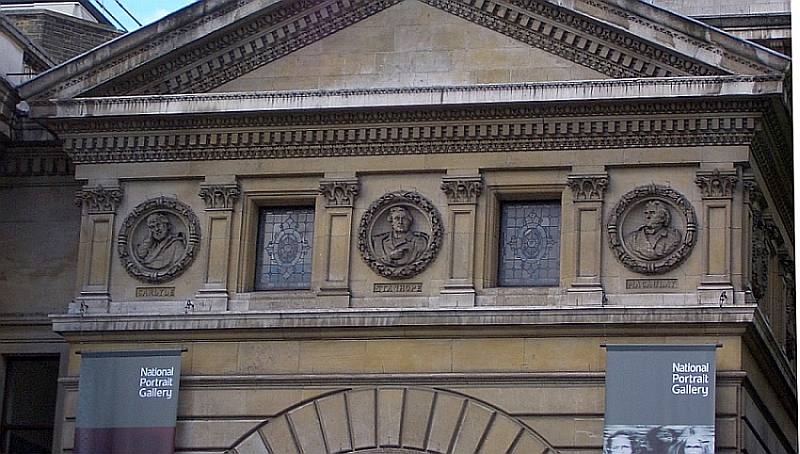
Detail of busts over the main entrance of the National Portrait Gallery, St Martin's Place, London. Ewan Christian. 1890-95; Orange Street wing, Sir Richard Allison, 1933; Ondaatje Wing, Dixon Jones Architects, 2000. [Entire building]
As an institution, the National Portrait Gallery dates from 1856, with the historian the Earl of Stanhope as its moving force, and Macaulay, Disraeli and Lord Ellesmere amongst its founding trustees. When Ellesmere died in the following year, he was replaced by Carlyle: hence the busts of Carlyle and Macaulay ("his two staunchest supporters," Bullus and Asprey 243) flanking Stanhope's over the main entrance of the building. The idea from the start was that the gallery should commemorate the subject rather than represent the artist; living sitters (apart from the monarch) and those who had died within the last 10 years were only eligible for inclusion from 1969.
For almost 40 years, the Director or Keeper of the NPG was the illustrator George Scharf, who died shortly before the collection got its permanent home here in 1895. Inspired by the oratory of Santo Spirito in Bologna, the Florentine Renaissance-style gallery was built on the site of the old St Martin's Workhouse, just north-east of the National Gallery on Trafalgar Square. It has a Portland stone facing, and is decorated with further roundels of major portrait artists, biographers and historians, all the work of Frederick Thomas. Amongst those celebrated in this way are Horace Walpole, Holbein, Van Dyck, Hogarth, Reynolds, Sir Thomas Lawrence and Chantrey. Christian too died shortly before the opening ceremony (see "Gallery History").
Related Material
- For George Scharf, see "Genre Painting and Common Life"
References
Bullus, Claire and Ronald Asprey. The Statues of London. London & New York: Merrell, 2009.
"Gallery History" (NPG site). Viewed 26 May 2009.
Photograph and commentary by Jacqueline Banerjee, 2009. [You may use these images without prior permission for any scholarly or educational purpose as long as you (1) credit the photographer and (2) link your document to this URL in a web document or cite the Victorian Web in a print one.]
Last modified 26 May 2009